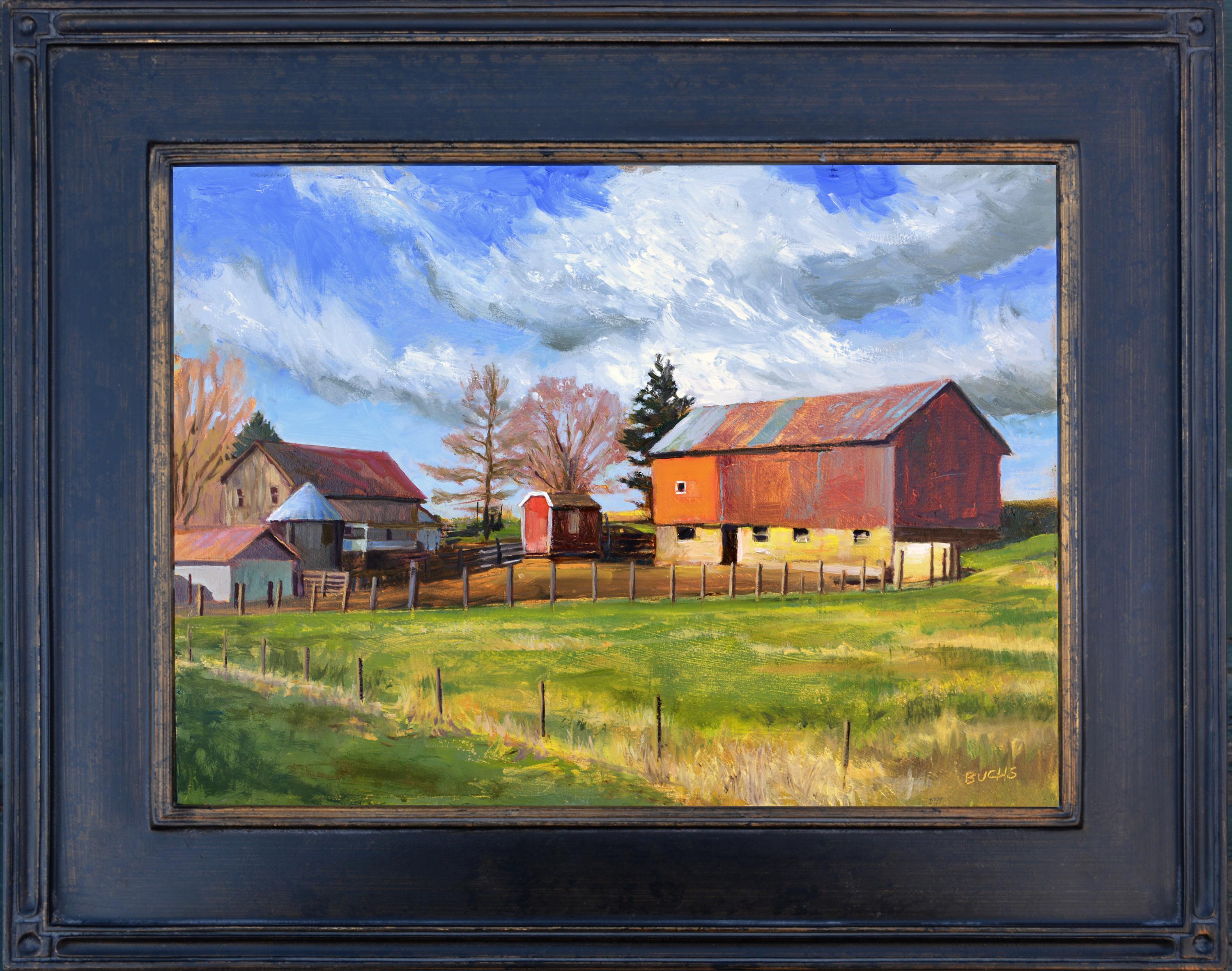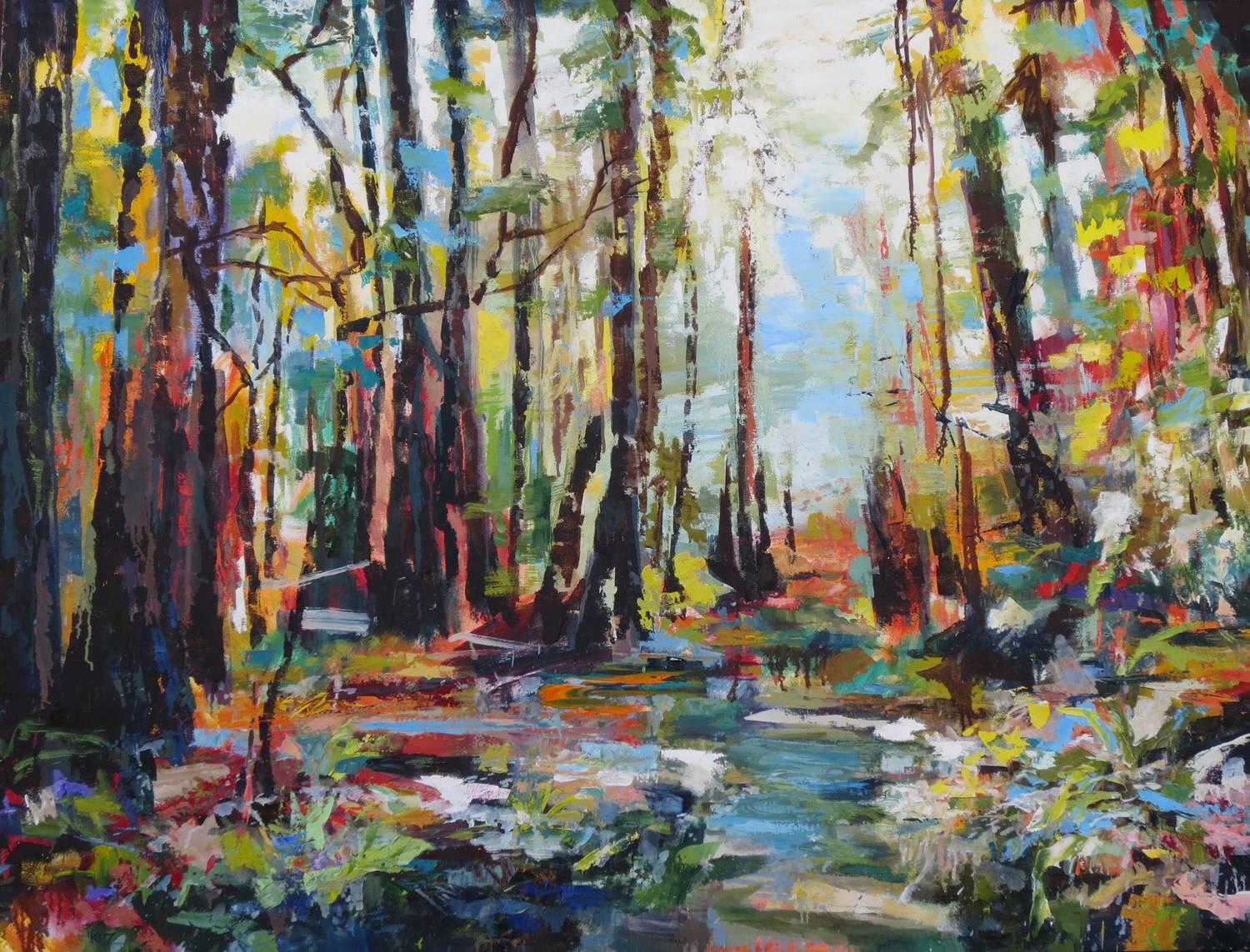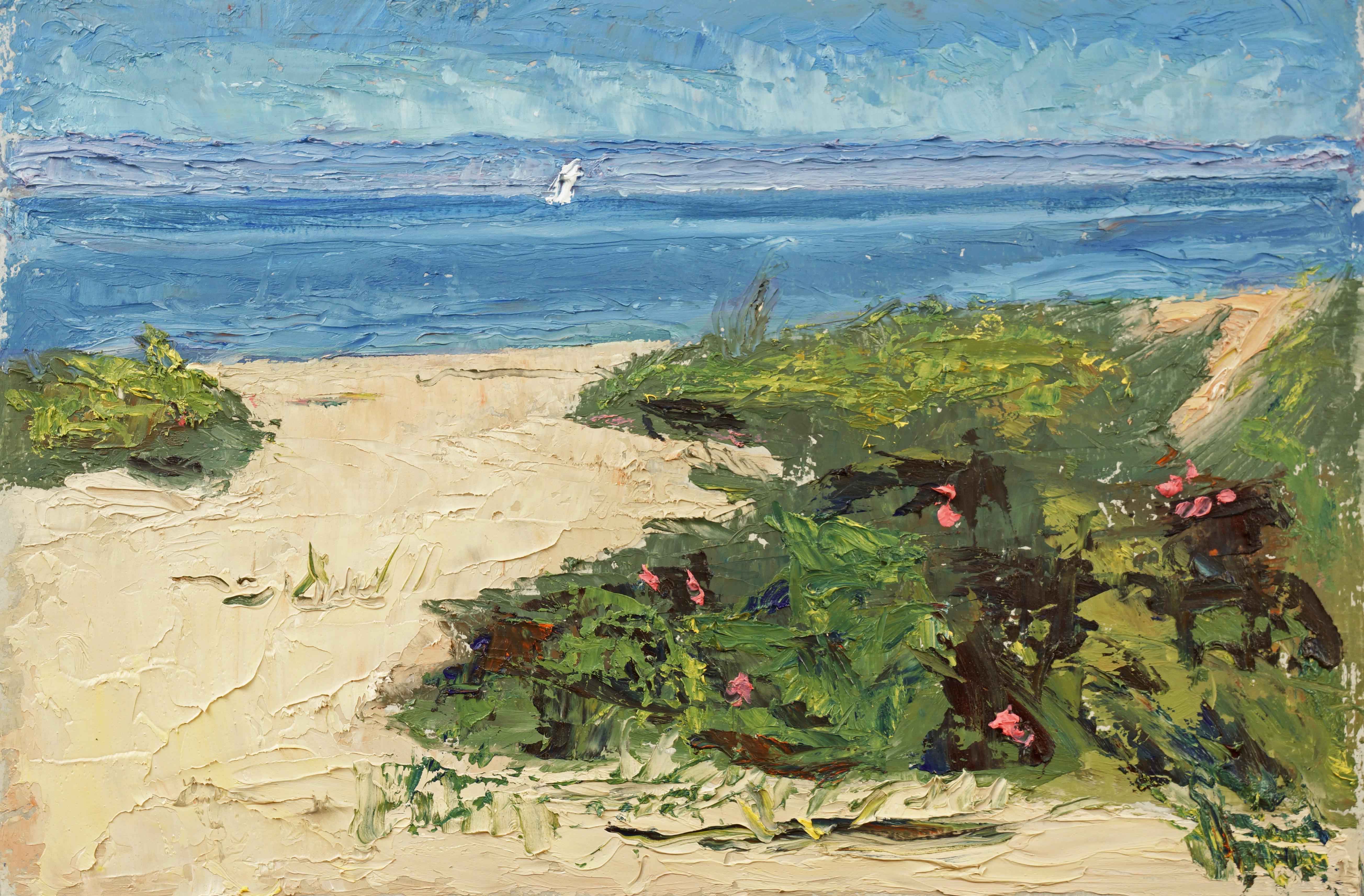Items Similar to "Autumn Landscape, " Theodore Wendel, American Impressionist, Giverny, France
Want more images or videos?
Request additional images or videos from the seller
1 of 9
Theodore Wendel"Autumn Landscape, " Theodore Wendel, American Impressionist, Giverny, France
About the Item
Theodore M. Wendel (1859 - 1932)
Autumn Landscape
Oil on canvas laid down on panel
10 1/2 x 16 inches
Signed lower right
Theodore Wendel is one of the most respected American impressionists and major museums and collectors are eager to purchase exquisitely rendered works like "View from the Artist's Farmhouse, Ipswich, MA" that display Wendel's finest period of impressionism. He is considered the "most French" of American painters along with Theodore Robinson and Childe Hassam.
Who Was Who in American Art states, "He was one of the most successful Impressionist landscape painters of Boston - and America…He was one of the few Americans whose works Monet chose to praise….[he was] one of the most important American Impressionists." American Art Analog states, "Theodore Wendel was one of the first American artists to embrace the form and technique of French impressionism….In the summer of 1886 he went to Giverny, the home of Monet, and joined an American colony of young artists, among them Louis Ritter, W.L. Metcalf, John Breck and Theodore Robinson. Wendel did not imitate Monet. However, he did Monet's hazy impressionism, vigorous brushwork and strong colors. He continued to use these techniques for the rest of his life."
Wendel was born in Midway, Ohio, in 1856 and lived in Newport (RI), Boston (1889-1898) and Ipswich (MA, 1898-). As a boy, he joined a circus as an arcobat. He studied with Thomas Noble at the McMicken School of Art at the University of Cincinnati, where he met and became a life long friend of Joseph DeCamp. He and DeCamp traveled to Munich, Germany, in 1878, to study with Frank Duveneck at the Munich Academy and they became known as "The Duveneck Boys."
Duveneck, Chase, Whistler, Twachtman and Wendel painted landscapes and figural paintings in Polling, Florence, and Venice from 1878-1880. Most of his paintings from this period disappeared and are very rare. He sailed for Newport, Rhode Island in 1882 and lived briefly in New York. In 1883, he exhibited in Cincinnati with Twachtman, DeCamp and Potthast and in that year Wendel and Louis Ritter moved to Boston (soon followed by DeCamp) and opened a studio.
From 1886-1888, Wendel studied in Paris at the Academie Julien and during the summers of 1887 and 1888 he became a close friend of Claude Monet and painted at Monet's gardens in Giverny with fellow American Theodore Robinson, Willard Metcalf and John Twachtman. These American immersed themselves in the study of the heightened colors and intense light of the more modern impressionist style of Monet. Wendel, Breck and Metcalf returned to Boston and in 1889, both Wendel and Metcalf held important exhibitions there.
Theodore M. Wendel (1859 - 1932)
Wendel married Philena Stone in 1897 and they moved to a large farm in Ipswich, Massachusetts inherited from her family. Although the artist retained a Harcourt studio in Boston (where many of his paintings burned in the 1904 fire), his heart was at the Ipswich farm, which he worked himself. In 1917 a mysterious and protracted illness curtailed Wendel's outstanding career. He died in Ipswich in 1932
.
Wendel is represented in many permanent museum collections including the Terra Museum of Art, Chicago; Metropolitan Museum of Art; Boston Museum of Fine Arts; Pennsylvania Academy of Fine Arts; the Cincinnati Art Museum and more.
- Creator:Theodore Wendel (1859-1932, American)
- Dimensions:Height: 20 in (50.8 cm)Width: 26 in (66.04 cm)
- Medium:
- Movement & Style:
- Period:
- Condition:
- Gallery Location:New York, NY
- Reference Number:1stDibs: LU1841210505892
About the Seller
5.0
Platinum Seller
These expertly vetted sellers are 1stDibs' most experienced sellers and are rated highest by our customers.
Established in 2021
1stDibs seller since 2022
60 sales on 1stDibs
Typical response time: 1 hour
- ShippingRetrieving quote...Ships From: Larchmont, NY
- Return PolicyA return for this item may be initiated within 3 days of delivery.
More From This SellerView All
- "Nantucket, Massachusetts" Helen Goodwin, American Impressionism Docks at HarborLocated in New York, NYHelen M. Goodwin (1865 - 1955) Nantucket, Massachusetts Oil on canvas laid on panel 12 x 16 inches Signed and titled lower right Helen M. Goodwin was born in New Castle, Indiana in ...Category
Early 20th Century American Impressionist Landscape Paintings
MaterialsOil, Panel, Canvas
- "Summer Landscape, " Joseph DeCamp, Boston Ten American ImpressionistsBy Joseph Rodefer DeCampLocated in New York, NYJoseph Rodefer DeCamp (1858 - 1923) Summer Landscape Oil on board 11 x 15 inches Signed lower right Born in Cincinnati, Ohio on November 5, 1858, Joseph DeCamp began his artistic career in his teens and remained active throughout his life. Although he initially painted landscapes, Decamp became a renowned and respected portraitist. He was famous for his images of men of high society and women within domestic interiors. Decamp began his artistic training in 1873 when he enrolled in the McMicken School of Art and Design in Cincinnati. The head of the school, Thomas Satterwhite Noble, was a European-trained painter whose "insistence on rigorous draftsmanship, true to the academic manner in which he had been trained, exerted a lasting influence on DeCamp." DeCamp studied under Noble for five years, but was also a student of Frank Duveneck at the Ohio Mechanics Institute. He adopted Duveneck's bold, realistic style and many of his paintings executed throughout the 1870s and 1880s reflect this influence. Like most American artists of his generation, DeCamp went abroad to study. In 1878, following in the footsteps of Duveneck and other Midwesterners, he traveled to Munich to attend the Royal Bavarian Academy. Soon after his arrival, however, he gravitated away from the academy and towards Duveneck and eventually followed his mentor to Florence and Venice. During these years, DeCamp focused on landscape and portraiture as his primary subjects. These themes would continue to occupy the artist when he returned to America in 1883. When DeCamp arrived back in the United States in 1883, he first settled in Cincinnati, but soon moved to Cleveland to teach at what is now Case Western Reserve University. He then relocated once more to the Boston area, where he would remain for most of his life. DeCamp began teaching at Wellesley Female Academy and, in the fall of 1885, began as an instructor at the School of Drawing and Painting at the Museum of Fine Arts in Boston. He quickly established himself as one of the leading figures in the Boston art community and became a founding member of The Ten American Painters, formulated in 1897. This group included Childe Hassam, John Henry Twachtman, Julian Alden Weir, Frank Benson, Thomas Dewing, Willard Metcalf, Robert Reid, Edward Simmons...Category
19th Century American Impressionist Landscape Paintings
MaterialsPanel, Oil
- "Concarneau, Brittany, France" Hayley Lever, American ImpressionismBy Hayley LeverLocated in New York, NYHayley Lever (1876 - 1958) Concarneau, Brittany, France, 1905 Oil on panel 6 3/4 x 9 1/2 inches Signed by the artist lower left Inscribed by another hand on the reverse Provenance: Clayton-Liberatore Galleries, Bridgehampton, New York Hayley Lever’s (1875-1958) versatility has worked against his posthumous reputation. He was never associated with a single artistic movement, instead producing impressionist, post-impressionist, and expressionist works. While best known as a painter of post-impressionist marine scenes, his subject matter included landscapes, urban scenes, and still lifes across his 60-year career. This lack of a singular style or subject has given him an amorphous place in U.S. art history despite his obvious accomplishments. [Richard] Hayley Lever was born in Bowden, South Australia in 1875. He excelled in painting classes at Prince Alfred College (1883-91) and Norwood Art School (1891-93) in Adelaide. In the 1890s, Lever moved to England, studying art in London and painting at St. Ives, a fishing port and popular artistic colony on the Cornish coast. In St. Ives, Lever shared a studio with Frederick Waugh, and studied painting with Albert Julius Olsson and Algernon Talmage. Lever was a plein air painter particularly interested in the effect of sunlight on the sea. He painted in a distinctive style, strongly influenced by the works of Vincent van Gogh, that might now be called post-impressionism. He used a limited palette to paint the St. Ives harbor, particularly at dusk or in the moonlight. His strong contrasting colors and thick use of paint created a crisp and physical surface that earned him acclaim in Europe. Lever’s many St. Ives seascapes are among his most popular works. In 2017, his painting entitled “The Old Lighthouse and Fleets of St. Ives” sold at auction for $162,500. In 1912, Lever moved to New York to test the art market in the United States. In Manhattan, Lever met prominent U.S. painters such as Ernest Lawson, Robert Henri, William Glackens, John Sloan, and George Bellows. Lever exhibited with this group regularly in New York City, painting parks, streets, bridges and the Manhattan waterfront. However, he soon discovered the scenic potential of Gloucester, Rockport, and Marblehead in the Cape Ann area of Massachusetts...Category
Early 1900s American Impressionist Landscape Paintings
MaterialsOil, Panel
- "On the Beach, " Nicolai Cikovsky, American Impressionism, Landscape SeascapeBy Nicolai CikovskyLocated in New York, NYNicolai S. Cikovsky (1894 - 1984) On the Beach Oil on panel 15 1/4 x 20 inches Signed lower right Provenance: ACA Galleries, New YorkCategory
Mid-20th Century American Impressionist Landscape Paintings
MaterialsOil, Panel
- "MacMahan's Maine, " Howard Everett Giles, Figurative Landscape, ImpressionismLocated in New York, NYHoward Everett Giles (1876 - 1955) MacMahan's Maine Oil on canvas backed with board 30 x 30 inches Signed lower right Provenance: Art Institute of Chicago Christie's New York, December 8, 2011, Lot 2 Howard Giles spent most of his career in New York City, where he was an educator, magazine illustrator, and painter who espoused the theory of Dynamic Symmetry. He was born in Brooklyn, and as a young man worked in a New York railroad office. Financial support of a family friend allowed him to study at the Art Students League with H. Siddons Mowbray. In early 1910, he became an illustrator for Scribner's Magazine, and in 1912, on sketching assignment for Scribner's went to England. During World War I, he did illustration for Harper's Monthly Magazine, and many of his images were 'roaring twenties' genre and figure paintings. In 1912, he began teaching life classes at the New York School of Fine and Applied Arts (later Parsons School of Design), and remained there until the late 1920s. During that time, he was also a part-time instructor at the Childs-Walker School in Boston, and accepted numerous invitations to lecture including at Carnegie Institute in Pittsburgh, Pennsylvania Academy of the Fine Arts, Detroit Institute of Arts and Wellesley College. His initial painting style was Impressionism, but he grew increasingly interested in other scientific, aesthetic theories. He worked with Jay Hambridge from 1916 to 1919, applying Hambridge's theory of Dynamic Symmetry to his painting and his lecture topics. From 1922 to 1926, Giles also worked with and was influenced in his own painting by colorist theorist Denman Ross, who espoused a limited and related color palette. For many of his paintings, Giles used watercolor although he also painted in oil and pastels. During the last years before his retirement when he moved to Woodstock...Category
Early 20th Century American Impressionist Landscape Paintings
MaterialsOil, Panel
- "Parisian Nocturne, France, " Frank Edwin Scott, American ImpressionismBy Frank Edwin ScottLocated in New York, NYEdwin Frank Scott (1863 - 1929) Parisian Noctune, France Oil on woof panel 8 1/4 x 10 1/2 inches Signed lower left Born in Buffalo, New York, Edwin Frank ...Category
Late 19th Century American Impressionist Landscape Paintings
MaterialsOil, Wood Panel
You May Also Like
- Industrial Impressionist Travel Mississippi River Fishing Bridge Sunrise SignedLocated in Milwaukee, WI"Mississippi Working Barge" is an original oil painting created by Thomas Buchs. This is a plein air painting that Thomas Buchs did on his travels. Buchs ...Category
2010s American Impressionist Landscape Paintings
MaterialsCanvas, Oil, Panel
- Neo Impressionism Landscape River Water Nature Travel Contemporary SignedLocated in Milwaukee, WI"River Crossing" is an original oil painting created by Thomas Buchs. This piece features a view from a riverbank peeking out of a thicket. Buchs shows a...Category
2010s American Impressionist Landscape Paintings
MaterialsPanel, Oil, Canvas
- Plein Air Neo Impressionism Farm Rural Nomad Travel Nature Contemporary SignedLocated in Milwaukee, WI"Windswept Farm" is an original oil painting on panel created by Thomas Buchs. Artwork Size: 12" x 16" Frame Size: 17 3/8" x 21 3/8" Artist Statement: ...Category
2010s American Impressionist Landscape Paintings
MaterialsCanvas, Oil, Panel
- Grove ClubBy Kim Ford KitzLocated in Mill Valley, CAKim Ford Kitz grew up in Southern California Beach towns, lived in San Francisco as a young adult, and now lives and works in a former furnit...Category
2010s American Impressionist Landscape Paintings
MaterialsCanvas, Oil, Panel
- "Trumans Beach, East Marion 06.06.2022" contemporary impressionist oil seascapeBy Nelson H. WhiteLocated in Sag Harbor, NY"Trumans Beach, East Marion 06.06.2022" is an almost-abstract palette knife landscape painting of a beach and beach shrubs. Off in the distance is a little white triangle of paint to emulate a sailboat...Category
21st Century and Contemporary American Impressionist Landscape Paintings
MaterialsCanvas, Oil, Panel
- "The Poppy Field 07.2021" contemporary impressionist oil paint red wildflowersBy Nelson H. WhiteLocated in Sag Harbor, NYThe Poppy Field 07.2021 is an abstract pallette knife landscape painting by third generation American Impressionist painter Nelson Holbrook White. Frame Dimensions: 19 x 27 inches...Category
21st Century and Contemporary American Impressionist Landscape Paintings
MaterialsCanvas, Oil, Panel
Recently Viewed
View AllMore Ways To Browse
Impressionist Landscapes Paris
Large Landscape French
Landscaping Stones
Landscapes German Painter
Stones Used In Landscaping
Boston Landscape
Early American Figure
Pennsylvania Landscapes
Landscape Large Impressionist
Massachusetts Landscaping
Massachusetts Landscape
American Impressionist Landscapes 20th Century
French Style Impressionist Landscape
Autumn Landscape
Autumn Landscape Art
German School Landscape Painting
German Impressionist
Long Island Landscape




